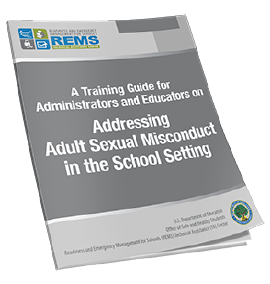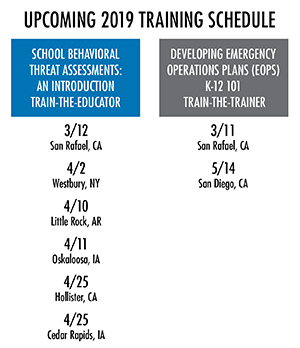|
Topical Resource Feature
This section of our newsletter features resources relevant to seasonal trends, current events, and other timely topics in the field.
Adult Sexual Misconduct and Youth Protection
While K-12 schools are entrusted to keep children safe every day, institutions of higher education (IHEs) often have youth and minors on their campuses each day. The presence of youths at IHEs can be a result of on-campus daycare facilities, youth summer camps at IHEs, field trips and other leadership programs for youths to visit campuses, and even K-12 schools located on IHE campuses. Thus, IHEs are responsible for keeping all students, staff, and visitors safe, and must prepare to prevent and protect youths from adult sexual misconduct (ASM). To help IHEs address this threat, the REMS TA Center’s Tool Box features the following resources developed by the University of Washington’s Office for Youth Programs Development and Support:
 To help K-12 schools and school districts understand ASM, develop related policies and procedures, train on ASM awareness and prevention, and recognize the role of social media and technology in ASM, the REMS TA Center released A Training Guide for Administrators and Educators on Addressing Adult Sexual Misconduct in the School Setting. For more resources on ASM, please visit the Addressing Adversarial- and Human-Caused Threats That May Impact Students, Staff, and Visitors Web page. Additionally, the Higher Education Protection Network offers resources and programs for practitioners who work to protect youths and children at IHEs.
To help K-12 schools and school districts understand ASM, develop related policies and procedures, train on ASM awareness and prevention, and recognize the role of social media and technology in ASM, the REMS TA Center released A Training Guide for Administrators and Educators on Addressing Adult Sexual Misconduct in the School Setting. For more resources on ASM, please visit the Addressing Adversarial- and Human-Caused Threats That May Impact Students, Staff, and Visitors Web page. Additionally, the Higher Education Protection Network offers resources and programs for practitioners who work to protect youths and children at IHEs.
|
|
Functional Resource Feature
This section of our newsletter features resources that can support education agencies and their community partners with efforts to strengthen emergency management functions and overall preparedness capacity.
Results From the REMS TA Center’s Comparative Analysis of Recommendations Made via State-Based School Safety Commission Reports and the Final Report of Federal Commission on School Safety
One month after the February 14, 2018, school shooting in Parkland, FL, the Federal Commission on School Safety (FCSS or the Commission) was formed. For nearly a year, the Commission reviewed research and went into American schools and communities to conduct meetings, field visits, and listening sessions with hundreds of parents, teachers, first responders, mental health professionals, and many others who shared their experiences and expertise regarding school violence. The result of those efforts was the December 2019 release of the Final Report of the Federal Commission on School Safety, which was submitted to the president on December 18, 2018. The Commission’s recommendations draw on research and best practices to help federal, state, and local governments support and improve school and community safety and support three broad categories of action: (1) prevent, (2) protect and mitigate, and (3) respond and recover.
To understand how state recommendations compare to those outlined in the FCSS Final Report, the REMS TA Center conducted research on 31 state-based commission reports produced since 2013 by key state or high-profile local entities on the topics of school safety, security, and emergency preparedness. Those states include the following:
- Alabama
- Alaska
- Arkansas
- Connecticut
- Florida (two reports)
- Georgia
- Idaho
- Illinois (two reports)
- Indiana
- Massachusetts
- Michigan
- Nevada
- New Hampshire
- New Jersey
- New York
- North Carolina
- Ohio
- Oregon
- Oklahoma
- Pennsylvania
- South Carolina
- Tennessee
- Texas
- Utah
- Virginia (two reports)
- Washington
- West Virginia
- Wyoming
By comparing the state-based reports to the FCSS recommendations, we sought to understand how well states are meeting federal recommendations and identify how the needs and recommendations of the states differ from those outlined in the FCSS Final Report. Similar to the formation of the FCSS Final Report, nearly 60 percent of the state-based commission reports were also developed in response to a local or national tragedy, mainly the Parkland and Newtown shootings. States with the most matching FCSS recommendations include Florida, Pennsylvania, and Virginia. States with the least matching FCSS recommendations include Oklahoma, Alaska, and Tennessee. The following graph shows how state-based reports matched FCSS recommendations across the three broad categories based on the five National Preparedness System Mission Areas: prevent, protect and mitigate, and respond and recover.

|
|
Help Desk Request Snapshot
This section of our newsletter highlights a noteworthy topic among technical assistance inquiries received from the field during the last quarter.
A Focus on Run, Hide, or Fight
A frequent request to the REMS TA Center is for clarification on the Run, Hide, or Fight options in an active shooter situation—i.e., running away from the shooter, seeking a secure place to hide and/or deny the shooter access, or incapacitating the shooter. The Guide for Developing High-Quality School Emergency Operations Plans and Guide for Developing High-Quality Emergency Operations Plans for Institutions of Higher Education (Guides), which were developed by several federal agencies and departments including the U.S. Department of Education (ED), provide detailed information on actions to take before, during, and after an active shooter incident.
The Guides point out that the fight option should be considered only by adults in immediate danger when confronted by a shooter, if neither running nor hiding are safe options. Also, the requirement to confront an active shooter should never be in a job description; how an employee responds in an active shooter situation should be up to him or her. There are many variables to every situation, and faculty and staff members should feel empowered by their administration to make their own decision about what response actions would be best if confronted with danger. Also, the recommendation to Run, Hide, or Fight does not replace any other common response protocols (i.e., lockdown, shelter-in-place, evacuation), but is intended to supplement them.
Check out the “Active Shooter Situations” section of the Guides for more information on Preparing for an Active Shooter Situation; Exercises; Preventing an Active Shooter Situation; Threat Assessment Teams; Responding to an Active Shooter Situation; Interacting With First Responders; and After an Active Shooter Incident.
|
|
#REMSontheRoad Spotlight
This section of our newsletter features details specific to the REMS TA Center Training by Request (TBR) and #REMSontheRoad Program.
An Overview of the Success of Our TBR Program
The REMS TA Center offers a variety of TBRs for delivery on site at schools, school districts, or IHEs. For each training, we will provide—free of charge—training materials, as well as one or more expert trainers and TA Center staff support for the event hosted at your site. To date, we have provided TBRs to more than 10,000 participants in 46 states, and in several territories. Training participants have included the following:
- Administrators (e.g., principals, directors, superintendents, etc.);
- Community partners (youth-serving organizations, mental health organizations, etc.);
- Educators;
- Emergency managers;
- First responders;
- Law enforcement agents (e.g., police officers, security guards, SROs, etc.);
- Mental health administrators (e.g., school psychologists, counselors, social workers); and
- Other (e.g., food services industry workers, maintenance workers, transportation services agents, etc.).

Download the REMS TA Center Trainings by Request: At a Glance document for more information on our training topics: https://rems.ed.gov/docs/TBRs_At-a-Glance_508C.pdf and view trainings we are hosting in April and May.
 Is your school, school district, or IHE interested in requesting oa live training for your education agency? Visit our TBR Web page to access details about the current training topics, and remember that every training we offer is 100 percent free! Our schedule is currently open to plan new trainings through September 2019, although our calendar is filling up fast!
Is your school, school district, or IHE interested in requesting oa live training for your education agency? Visit our TBR Web page to access details about the current training topics, and remember that every training we offer is 100 percent free! Our schedule is currently open to plan new trainings through September 2019, although our calendar is filling up fast!
Curious about whether a training is already scheduled in your area? Check out upcoming TBRs we have scheduled across the country by accessing the #REMSontheRoad forums on the REMS TA Center Community of Practice (CoP) or by viewing the graphic featured here. You can also share your experiences at any time with @remstacenter via Twitter using the #REMSontheRoad hashtag.
|
|
Virtual Networking Corner
This section of our newsletter features highlights from our interactions with the field via Twitter, the CoP, and other virtual events and networking platforms.
Upcoming and Archived Webinars and Web Chats
On Wednesday, March 27, 2019, from 2:00 p.m. to 3:00 p.m. ET, ED’s Office of Safe and Supportive Schools (OSSS) and REMS TA Center will host a webinar to highlight ED’s recently released document on the Family Educational Rights and Privacy Act of 1974 (FERPA). We will also discuss the importance of understanding FERPA when developing comprehensive emergency operations plans (EOPs). Michael Hawes, Director of the Student Privacy Policy and Assistance Division within ED’s Office of Planning, Evaluation, and Policy Development, will also join the webinar to provide an overview of School Resource Officers, School Law Enforcement Units, and the Family Educational Rights and Privacy Act (FERPA), the recently released guidance document that answers commonly asked questions to “explain and clarify how FERPA protects student privacy while ensuring the health and safety of students and others in the school community.” This event will also feature a dedicated 15-minute Q&A session during which presenters will field questions from participants.
This webinar will be available in archived format within 7-10 business days at the following link: https://rems.ed.gov/TA_Webinars.aspx.
Did you miss one of our recent webinars? View them via our website:
- Supporting Displaced Students and Their Families During and After Emergency Events. On Wednesday, February 27, 2019, ED’s OSSS and REMS TA Center hosted a webinar on the topic of supports for homeless and displaced students and families during and after emergencies that impact school district, school, and campus communities. Christina Dukes, from ED’s National Center for Homeless Education joined the webinar to provide a basic overview of why this topic is important and help provide insight that can help state and local education and emergency management agencies understand how they can provide further support. The webinar featured a Q&A session following the presentation (https://rems.ed.gov/DisplacedStudentsWebinar.aspx).
- Using SITE ASSESS for Higher Ed and K-12 Schools: Overview and Updates. On Wednesday, January 30, 2019, ED’s OSSS and REMS TA Center hosted a webinar to provide an overview of SITE ASSESS app, which includes its structure, design, and features, as well as how the REMS TA Center enhanced the app and expanded it to include IHEs. This 1-hour webinar included a PowerPoint presentation as well as a Q&A session following the presentation and a Twitter Chat. https://rems.ed.gov/SITEASSESS2019Webinar.aspx
Top @remstacenter Tweets for the Quarter
Are you on Twitter? Follow the REMS TA Center via @remstacenter, plus check out two of our top tweets for the past quarter, below. Keep these messages in mind and share them as you work with local education agencies and community partners in your states, territories, and localities to ensure safe and supportive learning environments.
|
If you have any questions or need additional assistance, please contact the REMS TA Center at  1-855-781-REMS [7367] or 1-855-781-REMS [7367] or  via email at info@remstacenter.org. via email at info@remstacenter.org. |
|

